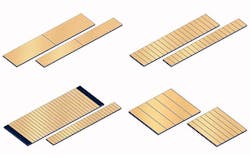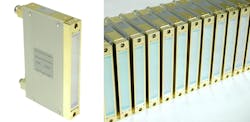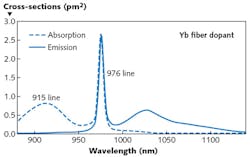Photonics Products: High-power Laser Diodes: Pump laser diodes deliver high power for leading-edge applications
In addition to its long life and small size, the laser diode (LD) has the highest wall-plug efficiency of any laser source known. As such, it provides much of the foundation for modern laser technology, and does this in two ways. First, LDs provide light at wavelengths from the UV to the mid-IR for many purposes. Second, LDs are extremely able pump sources for many types of optically pumped solid-state lasers, ranging from scientific to industrial, and ultrafast to continuous-wave (CW), as well as for a non-solid-state high-power laser, the diode-pumped alkali metal vapor laser (DPAL).
High-power LDs for laser pumping are commercially available in a huge range of wavelengths, physical configurations, beam characteristics, and other qualities. Laser-diode configurations include single emitters, bars (rows of single emitters), stacks (2D arrays), modules, bare chips, and so on, as well as CW, quasi-CW (QCW), and pulsed output. Because it is impossible to comprehensively cover such a variety of products in a short article, only a small sampling of what is available will be presented here.
It should be noted that two of the largest producers of high-power pump LDs are the well-known high-power laser makers IPG Photonics (Oxford, MA) and TRUMPF (Ditzingen, Germany). However, both these companies integrate virtually their entire output of pump LDs into their own diode-pumped laser products, and thus won't be covered here.
Efficient design
Because the amount of power needed to optically pump a multikilowatt solid-state or fiber laser is so high, efficient pump-source design is essential. "For any high-power application, power efficiency is one of the most crucial parameters, especially when dealing with several kilowatts of energy that could generate heat in the wrong place," says Pedro Muñoz, senior marketing manager of OSRAM Opto Semiconductors (Regensburg, Germany). "Heat not only diminishes the lifetime and performance of the laser, but it also requires more laser dies to achieve a certain power level and requires a more complex design for cooling. A poorly designed, inefficient system is usually more expensive and offers less performance."
To improve efficiency, Muñoz explains, not only are efficient lasers needed, but laser power must be combined from different LD sources and wavelengths in an efficient way. "To avoid stray laser light, you must direct light right where you need it and not heat up the laser machine instead of the pumping material, he says. "Although there are designs with free-space coupling, which can be done up to certain power levels, the cooling and electric driving requirements for the lasers is usually done in compact units known as stacks that are placed elsewhere in the laser machine. To deliver the laser light free from electronics and heat issues, allowing the active material to be pumped, fibers are commonly used."
Muñoz says that OSRAM's LD bars deliver laser light at a divergence angle of <8°, which remains constant at high operating currents and heat conditions, making it possible to couple virtually all light into small fiber cores, thus increasing the overall laser machine efficiency.
The company produces high-power indium aluminum gallium arsenide (InAlGaAs)-based infrared (IR) laser bars with multiple broad-stripe emitters (see Fig. 1) for pumping of solid-state lasers and fiber lasers (as well as for direct materials processing). Standard wavelengths include 808, 880, 915, 940, 960, 980, and 1020 nm, with 1060 nm in preparation. Typical output power is up to 250 W in CW and up to 500 W in QCW mode-OSRAM has demonstrated typical 65% wall plug efficiency (at 9xx nm) and >70% peak in mass production.
"We offer low-fill-factor laser bars for fiber-coupling, 50% fill-factor laser bars for CW operation, and 80% fill-factor bars for QCW coupling," Muñoz says. "We only offer the unmounted bare dies (as bars) for our customers who are familiar with the laser bar mounting technology, as that work can be very challenging and is a specialized art form itself."
Scalability
For very high-power applications, scalability of the pump-LD output power is key. As a result, laser-diode stacks are essential, says Jörg Neukum, product-line manager of high-power diode lasers at Coherent-DILAS (Santa Clara, CA, and Mainz, Germany). "Microchannel-cooled heat sinks offer the highest power per laser-diode array due to their best thermal management and can be stacked vertically and horizontally (see Fig. 2) to generate a 2D pump source tailored to the pump geometry," he explains. "Micro-optical beam shaping, generating both-axis collimated beams, can be combined with wavelength stabilization and spectral line narrowing using volume Bragg gratings (VBGs), offering temperature-insensitive, spectrally stable, narrow linewidth output for DPAL pumping or, to give some other examples, three-level neodymium (Nd3+) pumping, zero-phonon-line pumping of ytterbium (Yb3+), and pumping of erbium:YAG (Er3+:YAG) at 1532.25 nm, with an emission wavelength of 1645 nm."With appropriate both-axis collimation together with spectral stabilization, Neukum says, many vertical stacks can be lined up side-by-side to generate very high powers in the multikilowatt range. "Using VBGs for wavelength stabilization in principle generates competing resonators arising between the chip with its mirrors and the external VBG," he notes. "This limits the operating range (power/temperature) in principle, but placing an antireflection (AR) coating on the chip's front facet eliminates this problem and allows a much larger operating range with small linewidth and stable center wavelength."
Coherent-DILAS produces high-power pump LDs with a range of pump wavelengths for active media geometries such as rod, disk, slab, and fiber lasers, as well as for DPALs. As Neukum explains, the active laser dopants targeted by these LDs are mainly praseodymium3+ (440–450 nm), chromium3+ (640–670 nm), thulium3+ (785 nm), holmium3+ (1908–1940 nm), neodymium3+ (792-888 nm), ytterbium3+ (915-976 nm), and erbium3+ (960, 1470, and 1532 nm) in the solid-state and fiber-laser range, and cesium (852 nm), rubidium (780 and 795 nm), and potassium (766 nm) for DPAL applications. Pump powers range from 10 W up to multiple kilowatts.
Wavelength stabilization
Many types of diode-pumped solid-state and fiber lasers, as well as fiber-coupled laser diodes, are used in the medical and dental fields. "These medical applications require well-defined power, wavelengths, and safety features that fit perfectly in the final product designs," says Andre Timmermann, product-line manager of laser systems at LIMO (Dortmund, Germany). "Stabilization of all optical characteristics over a wide range of environmental parameters is key to receive the required FDA approval for medical products and applications."
As a result, pump LD modules made at LIMO for these purposes include integrated optical wavelength stabilization that keeps the wavelength of the LD constant over a wide range of output powers, Timmermann notes, who adds that the design is optimized to keep the electro-optical efficiency constant as well without any significant drift.
The company's LIMO15-F200-DL981-EX1524 module, which produces 15 W of power at a 981 nm center wavelength, is 108 × 19 × 25 mm in size and has a fiber-coupled output via a plug-and-play fiber connector. The wavelength temperature drift of the device is only 0.01 nm/K because of its wavelength stabilization.
Spectrally stabilized pump LDs produced by QPC Lasers (Sylmar, CA), which have gratings integrated into the diode structure itself that eliminate the need for VBGs, are aimed at a host of new and old applications that require spectrally narrowed, stabilized pumps, including fiber-laser pumping at 976 nm and rubidium pumping at 785 and 795 nm for medical imaging and alkali lasers (DPALs).
In one example of where stabilization is needed, fiber-laser manufacturers are moving to the 976 nm wavelength as the primary pump wavelength, as absorption at 976 nm is three times stronger as absorption at 915 nm. As a result, the fiber lasers can be made shorter, reducing optical nonlinearities. However, the narrow gain peak at the 976 nm wavelength requires accurate pump wavelength control and narrowed linewidth (see Fig. 3).QPC Lasers says that the cost, power, and efficiency of its wavelength-stabilized LDs are the same as for conventional diode pumps. The company produces near-IR diode emitters with outputs from 785 to 2000 nm in many types of configurations (thus fortuitously providing an example of how diverse this field is), including unpackaged chips, open-heat-sink lasers, single-mode fiber hermetic butterfly packages, multimode fiber-coupled modules, microchannel-cooled stacks, and OEM subsystems with cooling, power, and control.
For More Information
Companies mentioned in this article include:
OSRAM Opto Semiconductors
Regensburg, Germany
www.osram.com/os
Coherent-DILAS
Santa Clara, CA, and Mainz, Germany
www.dilas.com
LIMO
Dortmund, Germany
www.limo.de
QPC Lasers
Sylmar, CA
www.qpclasers.com
DISCLAIMER: While we try to include information from the broadest possible number of companies that manufacture the products featured in our Photonics Products series, because of limited word count as well as deadlines that cannot always be met by requested contributors, we cannot possibly include all companies and regret if your company is not included in our series.
About the Author
John Wallace
Senior Technical Editor (1998-2022)
John Wallace was with Laser Focus World for nearly 25 years, retiring in late June 2022. He obtained a bachelor's degree in mechanical engineering and physics at Rutgers University and a master's in optical engineering at the University of Rochester. Before becoming an editor, John worked as an engineer at RCA, Exxon, Eastman Kodak, and GCA Corporation.



